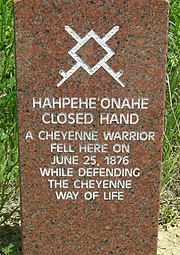| Little Bighorn Battlefield National Monument | |
|---|---|
|
IUCN category V (protected landscape/seascape) | |
| Location | Big Horn County, Montana, USA |
| Nearest city | Billings, Montana |
| Coordinates | 45°34′13″N 107°25′39″W / 45.57028°N 107.4275°WCoordinates: 45°34′13″N 107°25′39″W / 45.57028°N 107.4275°W |
| Area | 765.34 acres (309.72 ha)[1] |
| Established | January 29, 1879 |
| Visitors | 312,168 (in 2011)[2] |
| Governing body | National Park Service |
Little Bighorn Battlefield National Monument preserves the site of the June 25 and 26, 1876, Battle of the Little Bighorn, near Crow Agency, Montana, in the United States. It also serves as a memorial to those who fought in the battle: George Armstrong Custer's 7th Cavalry and a combined Lakota-Northern Cheyenne and Arapaho force. Custer National Cemetery, on the battlefield, is part of the national monument. The site of a related military action led by Marcus Reno and Frederick Benteen is also part of the national monument, but is about three miles (5 km) southeast of the Little Bighorn battlefield.[3]
History of site[]

Headquarters, from Last Stand monument
- 25 and 26 June 1876: Battle of Little Big Horn
- 29 January 1879: The Secretary of War first preserved the site as a U.S. National Cemetery, to protect graves of the 7th Cavalry troopers buried there.
- 1877: Custer, who had been buried there, was reinterred in West Point Cemetery.
- 7 December 1886: The site was proclaimed National Cemetery of Custer's Battlefield Reservation to include burials of other campaigns and wars. The name has been shortened to "Custer National Cemetery".
- 5 November 1887: Battle of Crow Agency, three miles north of Custer battlefield
- 14 April 1926: Reno-Benteen Battlefield was added
- 1 July 1940: The site was transferred from the United States Department of War to the National Park Service
- 22 March 1946: The site was redesignated "Custer Battlefield National Monument".
- 15 October 1966: The site was listed on the National Register of Historic Places.[4]
- 11 August 1983: A wildfire destroyed dense thorn scrub which over the years had seeded itself about and covered the site.[5] This allowed archaeologists access to the site.
- 1984, 1985: Archaeological digging on site.
- 10 December 1991: The site was renamed Little Bighorn Battlefield National Monument by a law signed by President George H. W. Bush.
Memorials[]
Panoramic photo of Custer National Cemetery

U.S. Army Memorial on Last Stand Hill

Indian Memorial
The first memorial on the site was assembled by Captain George K. Sanderson and the 11th Infantry. They buried soldiers' bodies where they were found and removed animal bones. In his official report dated April 7, 1879, Sanderson wrote:
"I accordingly built a mound out of cord wood filled in the center with all the horse bones I could find on the field. In the center of the mound I dug a grave and interred all the human bones that could be found, in all, parts of four or five different bodies. This grave was then built up with wood for four feet above ground. The mound is ten feet square and about eleven feet high; is built on the highest point immediately in rear of where Gen’l Custer’s body was found..."

Memorial Marker
Lieutenant Charles F. Roe and the 2nd Cavalry built the granite memorial in July 1881 that stands today on the top of Last Stand Hill. They also reinterred soldiers' remains near the new memorial, but left stakes in the ground to mark where they had fallen. In 1890 these stakes were replaced with marble markers.

Typical 7th Cavalry marker stone on the battlefield.
The bill that changed the name of the national monument also called for an "Indian Memorial" to be built near Last Stand Hill.
Markers honoring the Indians who fought at Little Big Horn, including Crazy Horse, have been added to those of the U.S. troops. On Memorial Day, 1999, the first of five red granite markers denoting where warriors fell during the battle were placed on the battlefield for Cheyenne warriors Lame White Man and Noisy Walking.

Cheyenne combatant marker stone on the battlefield.
The warriors' red speckled granite memorial markers dot the ravines and hillsides just as do the white marble markers representing where soldiers fell. Since then, markers have been added for the Sans Arc Lakota warrior Long Road and the Minniconjou Lakota Dog's Back Bone.
On June 25, 2003, an unknown Lakota warrior marker was placed on Wooden Leg Hill, east of Last Stand Hill to honor a warrior who was killed during the battle as witnessed by the Northern Cheyenne warrior Wooden Leg.
See also[]
References[]
- ↑ "Listing of acreage as of December 31, 2011". Land Resource Division, National Park Service. http://irma.nps.gov/Stats/DownloadFile/107. Retrieved 2012-05-14.
- ↑ "NPS Annual Recreation Visits Report". National Park Service. https://irma.nps.gov/Stats/Reports/National. Retrieved 2012-05-14.
- ↑ Little Bighorn Battlefield National Monument website
- ↑ National Register of Historic Places in Big Horn County, Montana
- ↑ www.nps.gov
- The National Parks: Index 2001-2003. Washington: U.S. Department of the Interior.
External links[]
| Wikimedia Commons has media related to Little Bighorn Battlefield National Monument. |
- Official NPS website: Little Bighorn Battlefield National Monument
- Friends of the Little Bighorn Battlefield
- Custer National Cemetery register
- History/cultural Tours.-Custer Battlefield Tours during reenactment.
- Grave of Curly
- Grave of White Man Runs Him
- How the Battle of Little Bighorn Was Won, from the Indians' point of view
- "Writings of Black Elk", broadcast from Little Bighorn Battlefield National Monument from C-SPAN's American Writers
The original article can be found at Little Bighorn Battlefield National Monument and the edit history here.
